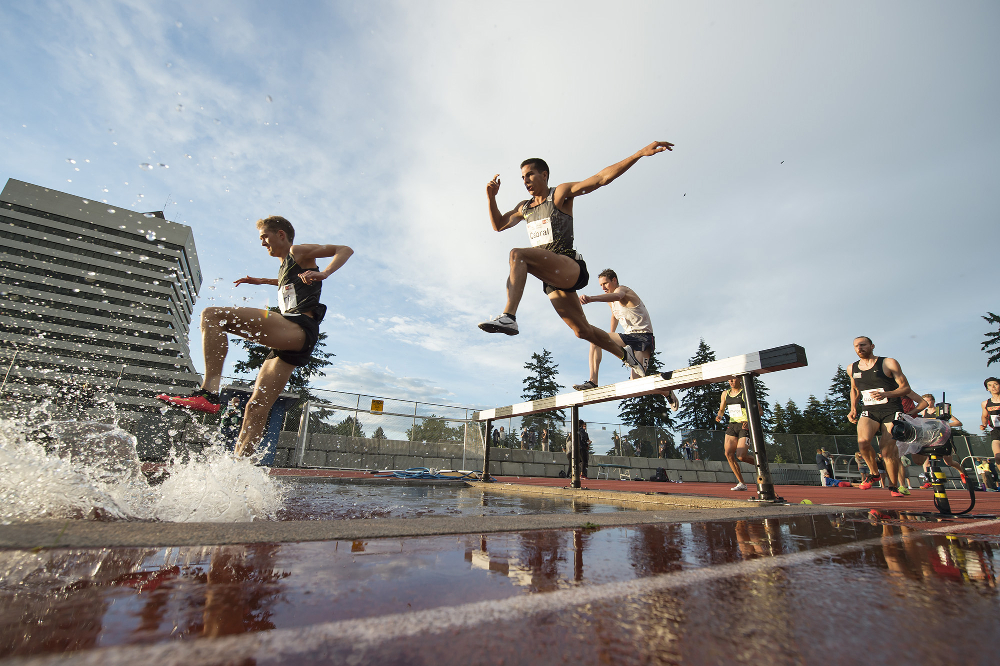The Mechanics and Techniques of Steeplechase Running: Steeplechase Olympics Fall

The steeplechase, a unique and demanding event in track and field, combines the endurance of long-distance running with the technical challenges of hurdle clearance and the added obstacle of a water jump. This unique combination of elements makes the steeplechase a truly captivating event, requiring a high level of athleticism, strategy, and mental fortitude.
The Unique Challenges of Steeplechase Running
The steeplechase presents unique challenges that distinguish it from other track and field events. The most significant of these challenges are the water jump and the barriers, which require specific techniques and strategies for successful execution.
The Water Jump
The water jump, a distinctive feature of the steeplechase, demands a combination of speed, technique, and courage. Runners must approach the jump with sufficient momentum to clear the water barrier while maintaining their speed. The key lies in finding the right balance between maintaining speed and ensuring a smooth, controlled entry into the water.
- Entry Technique: The optimal entry technique involves a slight lean forward at the moment of contact with the water, allowing the runner to maintain momentum and minimize the impact force. A proper entry angle minimizes the risk of losing speed and ensures a smooth transition back onto the track.
- Water Depth: The depth of the water jump is typically between 70-76 cm (28-30 inches), designed to challenge runners without posing a significant safety risk. The depth allows for a controlled entry and exit, minimizing the risk of injury.
- Impact Force: The impact force of entering the water is significant, and runners need to utilize proper technique to minimize the impact. A controlled entry with a slight lean forward helps distribute the impact force, minimizing the strain on the body.
The Barriers
The steeplechase barriers are similar in height and design to those used in other hurdle events, but the specific challenges they present are unique. The barriers are spaced at varying intervals, requiring runners to adapt their pace and hurdle technique to maintain momentum and efficiency.
- Hurdle Clearance: Steeplechase runners often utilize a “lead leg” technique, where the leading leg is brought forward over the barrier, followed by the trailing leg. This technique allows for a smoother and more efficient clearance, minimizing the loss of speed.
- Barrier Spacing: The varying spacing between barriers in the steeplechase demands a high level of adaptability from runners. They must adjust their stride length and pace to maintain momentum and avoid disrupting their rhythm.
- Rhythm and Timing: Maintaining a consistent rhythm and timing is crucial for successful barrier clearance. Runners must anticipate the location of each barrier and adjust their stride length accordingly to ensure a smooth and efficient transition over the obstacle.
Key Techniques and Strategies for Steeplechase Running, Steeplechase olympics fall
Success in steeplechase running requires a combination of endurance, speed, and technical proficiency. Runners must develop specific techniques and strategies to overcome the unique challenges of the event.
Pacing
Pacing is a crucial aspect of steeplechase running, as runners need to balance their energy expenditure over the course of the race while maintaining a competitive pace.
- Even Pacing: A consistent and even pacing strategy is often favored in the steeplechase. Runners aim to maintain a steady pace throughout the race, avoiding surges that could lead to fatigue and a decline in performance.
- Negative Splitting: Some runners may adopt a negative splitting strategy, where they run a slightly slower pace in the early stages of the race and gradually increase their speed in the latter stages. This strategy can be effective, but it requires careful planning and execution to avoid overexertion.
Hurdle Clearance
Successful hurdle clearance is essential for maintaining speed and efficiency in the steeplechase. Runners must develop a smooth and efficient technique to minimize the loss of momentum.
- Lead Leg Technique: The lead leg technique is commonly used in steeplechase hurdle clearance. This involves bringing the leading leg forward over the barrier, followed by the trailing leg. This technique allows for a smoother and more efficient clearance, minimizing the loss of speed.
- Body Position: Maintaining a proper body position is crucial for efficient hurdle clearance. Runners should lean slightly forward at the moment of contact with the barrier, keeping their core engaged and their body aligned. This helps to minimize the impact force and maintain momentum.
Water Jump Entry
The water jump presents a unique challenge, requiring a combination of speed, technique, and courage. Runners must approach the jump with sufficient momentum to clear the water barrier while maintaining their speed.
- Entry Angle: A controlled entry angle is essential for a smooth and efficient water jump. Runners should aim to enter the water at a slight angle, allowing them to maintain momentum and minimize the impact force.
- Impact Minimization: The impact force of entering the water is significant, and runners need to utilize proper technique to minimize the impact. A controlled entry with a slight lean forward helps distribute the impact force, minimizing the strain on the body.
Steeplechase olympics fall – The steeplechase, a race of grit and endurance, demands a balance of speed and strategy. Each hurdle, each water jump, tests the athlete’s limits, pushing them to the brink. Think of the artistry of Kenneth Rook’s visionary sculptures , capturing the raw power and delicate precision of human movement.
Just like Rook’s works, the steeplechase demands a perfect blend of form and function, where the fall of a runner can be as dramatic as the triumph of a finish.
The steeplechase Olympics fall is a spectacle of grit and grace, where athletes navigate water jumps and hurdles with unwavering determination. One such champion, Soufiane El Bakkali, embodies this spirit. His journey, documented here , showcases the resilience and dedication required to conquer this demanding race.
The steeplechase Olympics fall is a testament to human potential, a battle against fatigue and a celebration of athletic excellence.